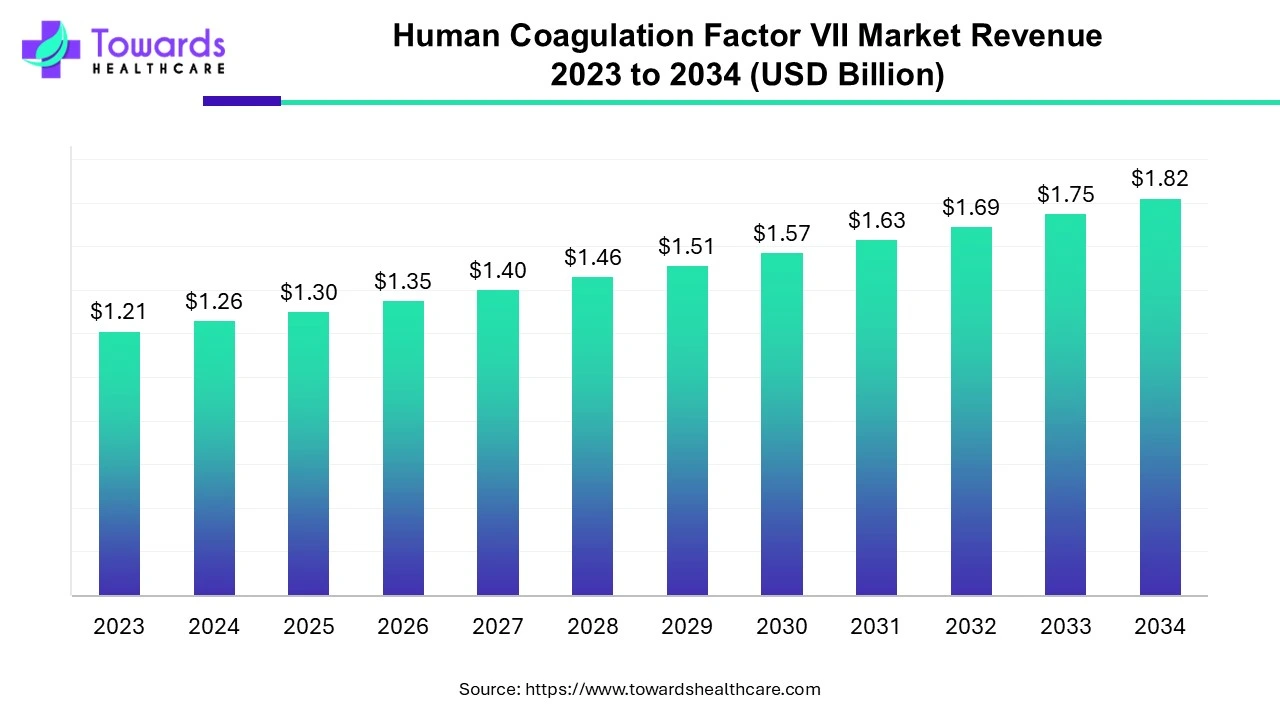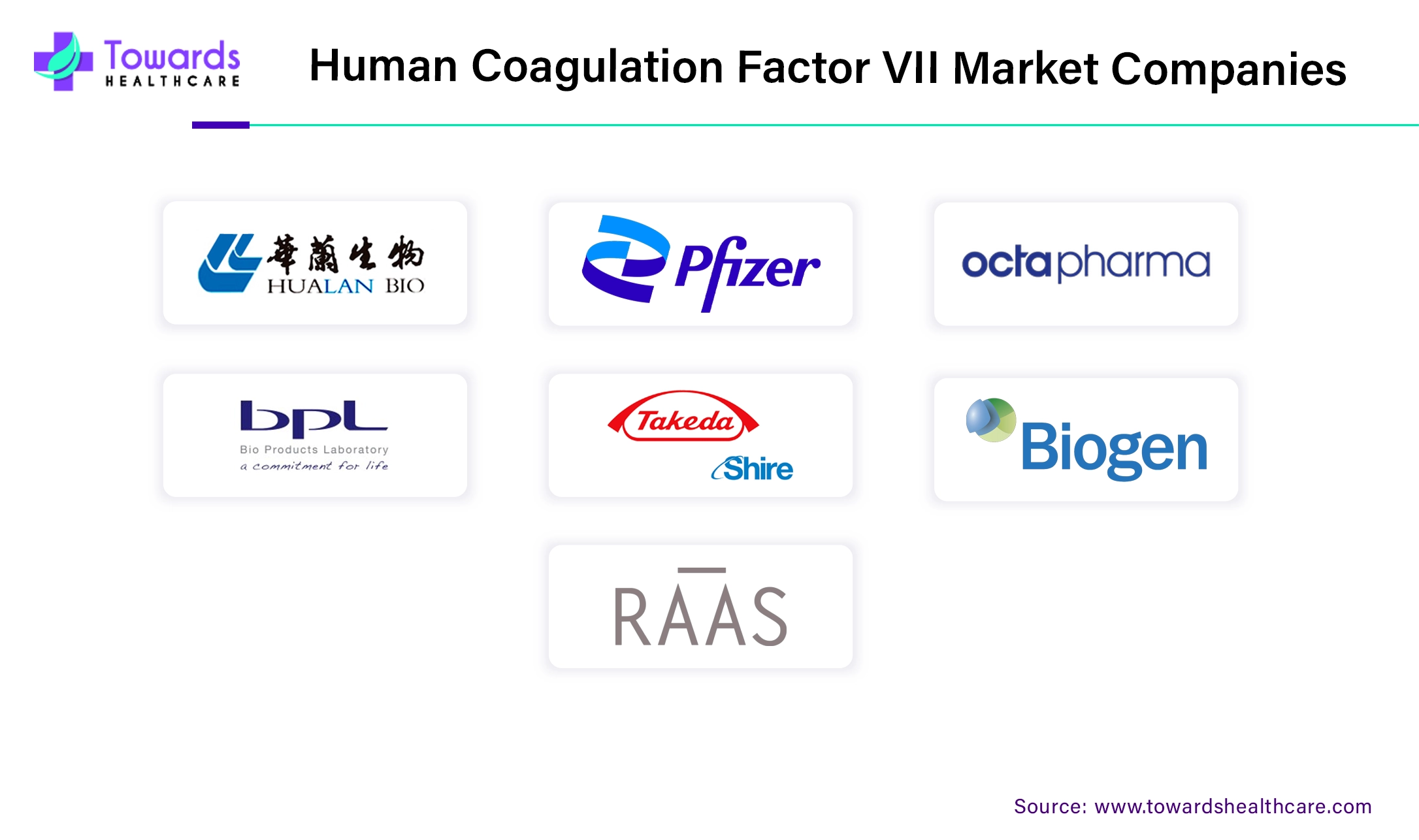November 2024

The global human coagulation factor VII market size was estimated at US$ 1.21 billion in 2023 and is projected to grow to US$ 1.82 billion by 2034, rising at a compound annual growth rate (CAGR) of 3.74% from 2024 to 2034. Human coagulation factor VII is used to prevent bleeding, and growing cases of accidents and trauma are increasing the demand for coagulation factor VII.

Human coagulation factor VII is a clotting factor used for preventive bleeding. Excessive bleeding is a life-threatening condition that can happen in people suffering from hemophilia during surgeries and during accidents & trauma. In such situations, an external dose of coagulation factors is needed. With growing cases of hemophilia and a number of surgeries, the demand for human coagulation factor VII is going to grow in the future.
The human coagulation factor VII market is anticipated to grow significantly due to the increasing geriatric population. People in their old age are more prone to health issues that require one or more surgeries. Many people go through multiple due to serious or multiple health issues. Human coagulation VII is a major product used during surgeries to avoid excessive bleeding. Therefore, the growing geriatric population is an indication that the demand for human coagulation factor VII will grow in the future.
The high expense of factor VII treatments may prevent some patients from accessing them, especially in poorer nations, limiting market expansion. The intricate regulatory framework and drawn-out approval procedures for novel treatments may also hamper the commercial launch of novel products. Potential adverse effects that discourage some patients and healthcare professionals may also impact the uptake of Factor VII therapy.
North America dominated the human coagulation factor VII market in 2023.
The major factors that promote the market’s growth in North America are the growing number of surgeries, government support, the growing healthcare & pharmaceutical industry, and growing research and development. Apart from this, people in North America are aware of blood donation because a lot of people donate blood and blood products, which are useful in gathering coagulation factors. There are various organizations that actively make efforts to collect blood products, store them, and deliver them whenever needed. The human coagulation factor VII market is significantly growing in the U.S. and Canada. The U.S. holds the largest share, followed by Canada.
For instance,
More than 25% of all healthcare-related expenses in the US are related to surgery, which is a growing expense. About 40 to 50 million major operations are carried out annually in the US and 20 million in Europe, out of 310 million worldwide.
Asia Pacific is expected to grow at the fastest rate during the forecast period.
The human coagulation factor VII market is rapidly growing due to the growing population, especially the geriatric population. A large population is a major factor leading to a growing number of surgeries. During surgeries, coagulant factor VII is used to avoid excessive bleeding.
For instance,
An estimated 30 million surgeries are performed annually in India. Remarkably, corporate hospitals only do 15% of procedures, whereas smaller and mid-size hospitals perform 85% of them. Nearly 50 million operations are required in India each year. It is estimated that there are about 23,000 procedures for every 100,000 people in high-income nations.
By product type, the plasma-derived factor VII segment held the largest share of the human coagulation factor VII market in 2023. Various coagulation factors are used for blood clotting to prevent excessive bleeding. Human coagulation factor VII is derived from human plasma stored and used for hemophilia patients and during surgeries.
The recombinant factor VII segment is anticipated to grow at the fastest rate during the forecast period. Hemostasis initiation is significantly aided by recombinant activated factor VII. With an effectiveness of about 90% at conventional dosages of 90 μg/kg, recombinant activated factor VII (rFVIIa) has emerged as the first-line treatment for both surgical and non-surgical bleeding in many institutions. Early treatment beginning and perhaps higher dosages of rFVIIa are linked to increased effectiveness.
By application, the hemophilia segment held the major share of the human coagulation factor VII market in 2023. Hemophilia A patients' treatment is associated with high coagulation factor concentrate costs. Hemophilia A and B, which are thought to afflict 1 in 5000 and 1 in 30,000 neonates globally, respectively, are more common in boys than in females. Therefore, it is safe to predict that there are around 1.1 million hemophiliacs in the globe, with about 400,000 of them likely to have severe hemophilia. The annual cost of blood clotting factors for treating a single patient with hemophilia B can reach $450,000, and the entire cost of therapy may exceed $20 million or more, even in rich countries like the US, Germany, Japan, and others.
The surgery segment is estimated to grow at the fastest CAGR during 2024-2034. Excessive bleeding can happen during surgery and post-surgery. To control bleeding, human coagulation factor VII becomes necessary during surgeries. The segment is estimated to grow the fastest due to the growing population, growing geriatric population, and a growing number of accidents.
By end-user, the hospitals segment was dominant in the human coagulation factor VII market in 2023. Patients with hemophilia or other health issues that require surgery are hospitalized for treatment and monitoring. The majority of patients are admitted to hospitals due to the presence of adequate resources and healthcare professionals from multiple disciplines to provide quality care.
The ambulatory surgery centers segment is expected to grow significantly during the predicted timeframe. For most patients, ASCs are a cost-effective alternative since they are often less expensive than hospital surgical treatments. This is so because outpatient operations don't involve the extra expenses of overnight hospital stays, such as ward fees, food, nursing care, and certain supplies.

By Product
By Application
By End-User
By Region
November 2024
October 2024
October 2024
October 2024